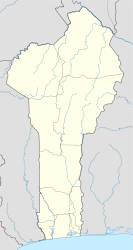Cotonou, Benin
| Cotonou | |
|---|---|

Aerial view of Cotonou in January 2017.
|
|
| Location of Cotonou in Benin | |
| Coordinates: 6°22′N 2°26′E / 6.367°N 2.433°ECoordinates: 6°22′N 2°26′E / 6.367°N 2.433°E | |
| Country |
|
| Department | Littoral Department |
| Government | |
| • Mayor | Nicéphore Soglo (2008–2014) |
| Area | |
| • Total | 79 km2 (31 sq mi) |
| Elevation | 51 m (167 ft) |
| Population (2012) | |
| • Total | 779,314 |
| • Density | 9,900/km2 (26,000/sq mi) |
Cotonou (French pronunciation: [kɔtɔˈnu]), formerly Kutonu, is the largest city and economic centre of Benin.
Its official population count was 761,137 inhabitants in 2006; however, some estimates indicate its population to be as high as 1.2 million; the population in 1960 was only 70,000. The urban area continues to expand, notably towards the west. The city lies in the southeast of the country, between the Atlantic Ocean and Lake Nokoué.
In addition to being Benin's largest city, it is also the seat of government, although Porto-Novo is the official capital. It is home to most of the country's government buildings and diplomatic services. The city is a major port, and is also home to an airport and a railway that links to Parakou. Other features of Cotonou include Cotonou Friendship Stadium, Cotonou Cathedral, Cotonou Central Mosque, the Ancien Pont Bridge and the 20-hectare Dantokpa Market, which has a commercial turnover of over one billion CFA Francs a day. Another familiar feature of the city is the motorcycle-taxis known as Zémidjans.
The name "Cotonou" means "by the river of death" in the Fon language. At the beginning of the 19th century, Cotonou (then spelled "Kutonou") was a small fishing village. Though originally ruled by the Kingdom of Dahomey, in 1851 the French made a treaty with the Dahomean King Ghezo that allowed them to establish a trading post at Cotonou. During the reign of Glele, his successor (1858–89), the territory was ceded to France by a treaty signed on May 19, 1868. In 1883, the French navy occupied the city to prevent British conquest of the area. After Glele's death in 1889, his son Béhanzin tried, unsuccessfully, to challenge the treaty. From then on, the town developed quickly to become the largest harbour in the region.
...
Wikipedia

